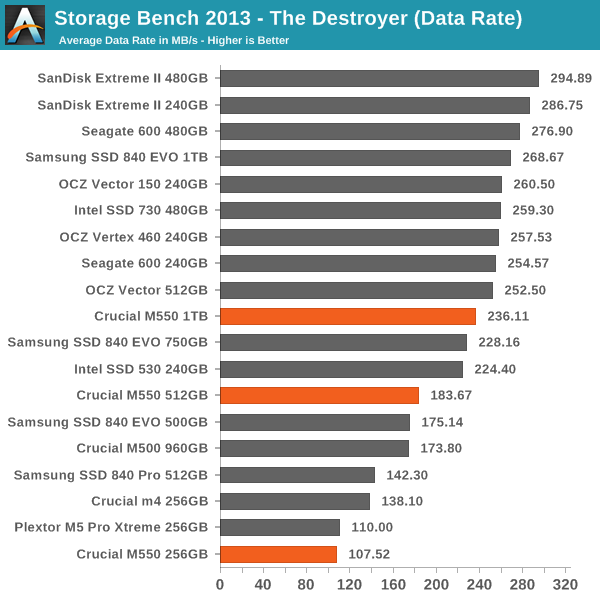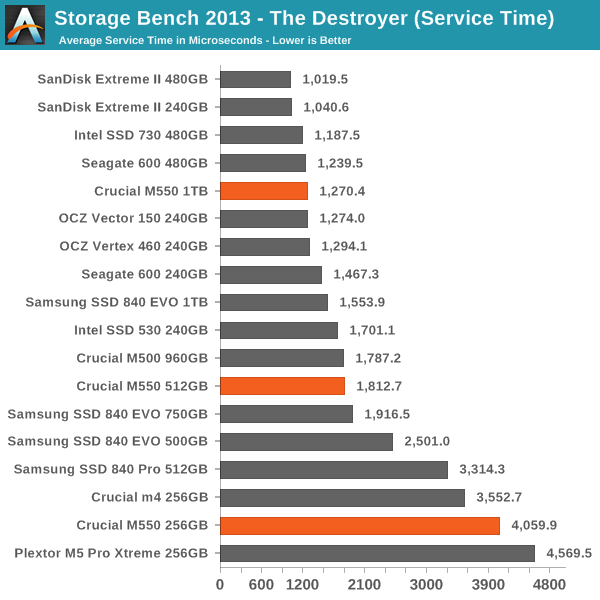Crucial M550 Review: 128GB, 256GB, 512GB and 1TB Models Tested
by Kristian Vättö on March 18, 2014 8:00 AM ESTAnandTech Storage Bench 2013
Our Storage Bench 2013 focuses on worst-case multitasking and IO consistency. Similar to our earlier Storage Benches, the test is still application trace based—we record all IO requests made to a test system and play them back on the drive we're testing and run statistical analysis on the drive's responses. There are 49.8 million IO operations in total with 1583.0GB of reads and 875.6GB of writes. As some of you have asked, I'm not including the full description of the test for better readability, so make sure to read our Storage Bench 2013 introduction for the full details.
| AnandTech Storage Bench 2013 - The Destroyer | ||
| Workload | Description | Applications Used |
| Photo Sync/Editing | Import images, edit, export | Adobe Photoshop CS6, Adobe Lightroom 4, Dropbox |
| Gaming | Download/install games, play games | Steam, Deus Ex, Skyrim, Starcraft 2, BioShock Infinite |
| Virtualization | Run/manage VM, use general apps inside VM | VirtualBox |
| General Productivity | Browse the web, manage local email, copy files, encrypt/decrypt files, backup system, download content, virus/malware scan | Chrome, IE10, Outlook, Windows 8, AxCrypt, uTorrent, AdAware |
| Video Playback | Copy and watch movies | Windows 8 |
| Application Development | Compile projects, check out code, download code samples | Visual Studio 2012 |
We are reporting two primary metrics with the Destroyer: average data rate in MB/s and average service time in microseconds. The former gives you an idea of the throughput of the drive during the time that it was running the test workload. This can be a very good indication of overall performance. What average data rate doesn't do a good job of is taking into account response time of very bursty (read: high queue depth) IO. By reporting average service time we heavily weigh latency for queued IOs. You'll note that this is a metric we've been reporting in our enterprise benchmarks for a while now. With the client tests maturing, the time was right for a little convergence.

The relatively poor IO consistency shows up in our Storage Bench 2013 as well. We are looking at about Samsung SSD 840 EVO level performance here (when taking the difference in over-provisioning into account), which is certainly a step up from the M500 but in the end the M550 is just a mediocre performer.











100 Comments
View All Comments
Cerb - Sunday, March 23, 2014 - link
It's just that Samsung and Sandisk/Toshiba developed that technology for their flash, and Micron/Intel decided to go all in to making it denser, instead. There's nothing "Pro" about the 840, nor Toshiba's Q, with a, "Pro," after them, other than the name. Hell, gaming video cards have had "Pro" suffixes.Samsung and Toshiba/Sandisk decided to develop and use that kind of technology (it's in the Q series, with no marketing at all, and in Sandisk's Ultra Plus (X110?) and Extreme II (X210?) as ncache), while Intel/Micron went all in for density and cost, instead.
It's generally useful, as it can allow a first stage of buffering to fake SLC, so live data writes generate less wear. So, bursty writes and random writes can both perform better, and wear the flash out less, than if it were pure TLC or MLC. I suspect it will find its way into server products over the next few years, as well, if it's not already hiding in something of Toshiba's.
Also, just as there's been increased demand for 7200 RPM SATA and SAS for professionals, plain SATA SSDs are all most users need, as well. Pro users are using the same classes of drives as consumers, for the most part.
JBVertexx - Tuesday, March 18, 2014 - link
I also agree this is positioned as a mainstream drive but with the additional performance and features upping the ante.It's hard to argue with price. The last several SSDs I have purchased have been the M500 240GB model. The current price of the 550 is what the 500 was only 3 months ago. So I would expect the positioning of the 550 to continue the price/value leadership position as it eventually replaces the M500. My bet is that the volumes of M500s that have been selling for them support this positioning as a winning one for Crucial.
MrSpadge - Tuesday, March 18, 2014 - link
Agreed - the M500 is really putting price pressure on everyone else. For this benefit I can live with slightly lower performance. If M550 at 120/240 GB comes even close in price it's a default win. It has to be cheaper than 840 Evo, though.trichome333 - Wednesday, March 19, 2014 - link
Agreed, just got a 240gb M500 for $115. Read is up there with any SSD which is all I care about.laviathan05 - Tuesday, March 18, 2014 - link
On a personal note, as a person who bought a new Samsung EVO 1TB drive yesterday, I'm pleased with this review. Also, if you follow the link in the pricing chart you'll see that it currently is selling for $470 on newegg.Jaguar36 - Tuesday, March 18, 2014 - link
In your final words you mention that "It has the best-in-class encryption support", How come you don't say anything else about this in the article? What exactly does best in class mean?Kristian Vättö - Tuesday, March 18, 2014 - link
"There is TCG Opal 2.0 and IEEE-1667 support, which are the requirements for Microsoft's eDrive encryption."It's something we've covered before so I only mentioned it in the review. Clicking the eDrive link leads to an article where the M500 is tested with eDrive, so you'll see the benefits there.
Jaguar36 - Tuesday, March 18, 2014 - link
Thanks!just4U - Tuesday, March 18, 2014 - link
When looking at SSD's to purchase I settled on 3 Intel, Samsung, and Crucial. The controller on the Intel and the fact that it was priced in the range of the Samsung led to me dropping it as a choice. So that left me with Samsung/Crucial. Given the choice I'd go Samsung.. as it is a higher performing drive but price/availability I wouldn't be to terrible upset if I had to go with the Crucial drives.I think maybe they just let performance take a back seat because their other drive was popular even though it was slower than the rest of the pack. It gained a good reputation so their hoping that will carry over to this new slightly faster/feature rich incarnation.
extide - Tuesday, March 18, 2014 - link
Were you talking an Intel SF drive (300/500 series?) or the 720, with the super sweet in-house controller? Also don'[t forget about the Sandisk Extreme II...IMO The Top Tier performance drives are (In no specific order):
Sandisk Extreme II
Intel 720 Series
Crucial Neutron GTX
Samsung 840 Pro
Seagate 600
OCZ Vector 150
And the best in terms of capacity/price:
Crucial M500 (& M550?)
Samsung 840 EVO